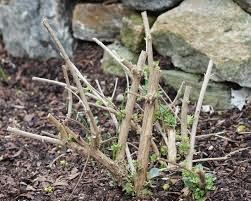 |
Pruning photo Cyrus McCrimmon, Denver Post
|
This article is an excerpt from the CMG Garden Notes publication Pruning Flowering Shrubs and is re-printed here because of the extreme timeliness of the information – early spring is the time for rejuvenation pruning! http://www.ext.colostate.edu/mg/Gardennotes/616.html
 |
Rejuvenation photo by sherisilver.com
Pruning has a major influence on shrub flowering. Over time, an unpruned flowering shrub becomes woody with little new growth to support flower bud development. Summer-flowering shrubs bloom on new wood that grew earlier in the growing season. Summer-flowering shrubs can be pruned by rejuvenation in the early spring before growth starts.
Rejuvenation pruning is different from other pruning methods such as thinning or shearing. With rejuvenation, the shrub is cut 4 to 6 inches above the ground in the early spring before growth starts. The shrub regrows from roots, giving a compact, youthful plant with maximum bloom. Rejuvenation can have a major effect on size. This method is preferred for many flowering shrubs because it is quick and easy with great results. Initial rejuvenation should be followed by thinning new canes to several strong ones over the next several years. Remove weak cane growth at the base (ground level).
Rejuvenation is typically done no more than every 3 to 5 years when a shrub begins to look gangly and woody. It works very well on multi-stemmed, twiggy-type shrubs such as:
- butterfly bush (Buddleia spp. and Cassia spp.)
- spirea (Spiraea spp.)
- blue mist spirea (Caryopteris x clandonensis),
- potentilla or creeping cinquefoil (Potentilla reptans)
- red-twig dogwood (Cornus sericea)
- sumac (Rhus spp.)
- hydrangea (Hydrangea spp.)
(Note: Caryopteris will flower best if renewed each spring.)
Also use this method to rejuvenate some less-twiggy shrubs such as:
- lilac (Syringa spp.),
- privets (Ligustrum spp.)
- barberry (Berberis spp.)
- forsythia (Forsythia spp.)
- honeysuckle (Lonicara spp.)
Limitations:
- Spring-flowering shrubs (vs. summer-flowering) will not bloom the year of rejuvenation.
- On shrubs with a rock and weed fabric mulch, rejuvenation may not be successful due to decreased root vigor and interference of the mulch with growth from the base.
- Extremely overgrown shrubs with large woody bases may not respond well to rejuvenation pruning.
- Shrubs with a lot of dead branches will not respond well to rejuvenation pruning. As a rule of thumb, if more than one-third of the branches are woody, without healthy foliage, the shrub will probably not respond.
- Some shrubs are structurally more like small trees with only one or a few primary trunks. They include several Viburnum and Euonymus species, and shrubby forms of Rhamnus (buckthorn). Don’t cut these shrubs to the ground. Prune by thinning branches back to a side branch.
- Lilac cultivars budded onto common lilac rootstocks should not be cut to the ground. Regrowth will be common lilac rather than the selected cultivar.
I experimented with rejuvenation pruning last spring. I admit I was nervous and only pruned a few of my summer-blooming bushes…the results were awesome! All the shrubs came back and bloomed as if they were in their prime! If you have questions you can find telephone numbers for Colorado Master Gardeners' hotlines from around the state at this website: http://cmg.colostate.edu/ask-cmg.shtml
See the Plantalk ColoradoTM article Renewing Shrubs : http://www.ext.colostate.edu/ptlk/1729.html
See the CSU Extension publication Native Shrubs for Colorado Landscapes:
